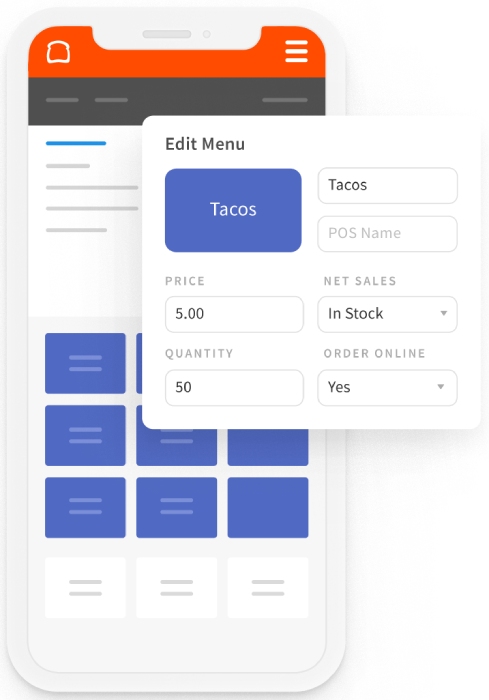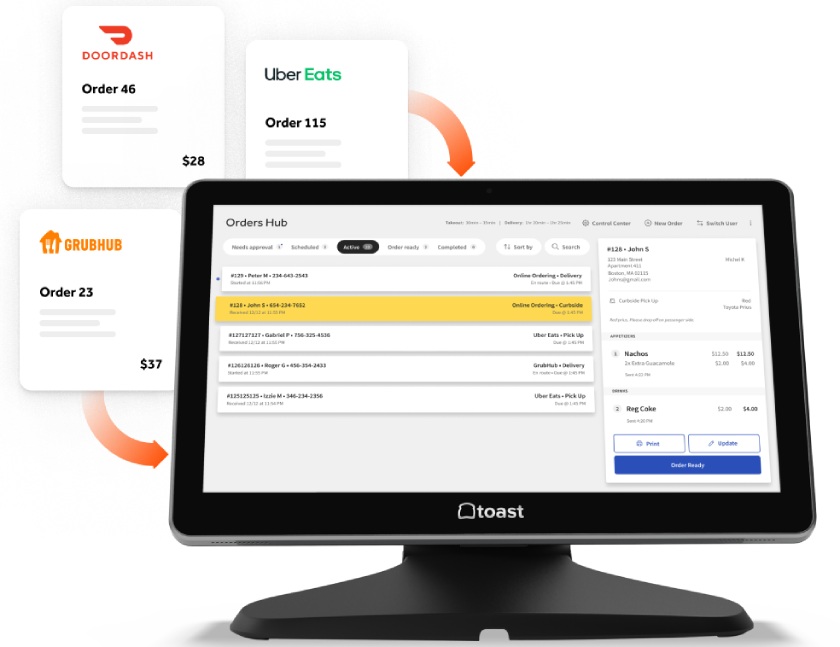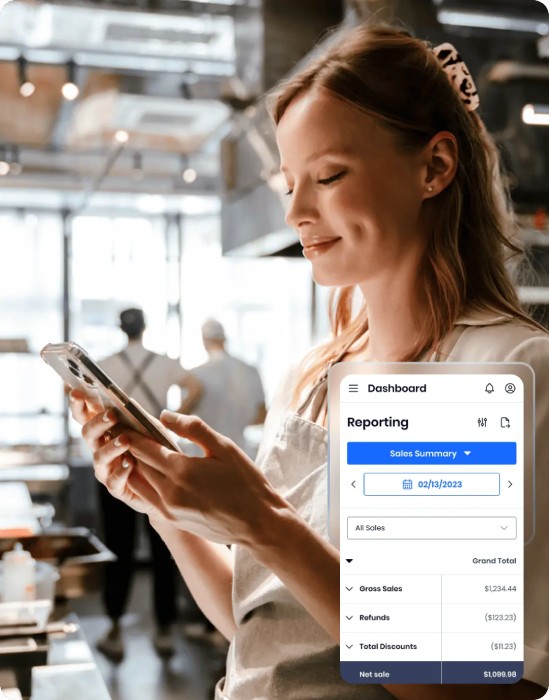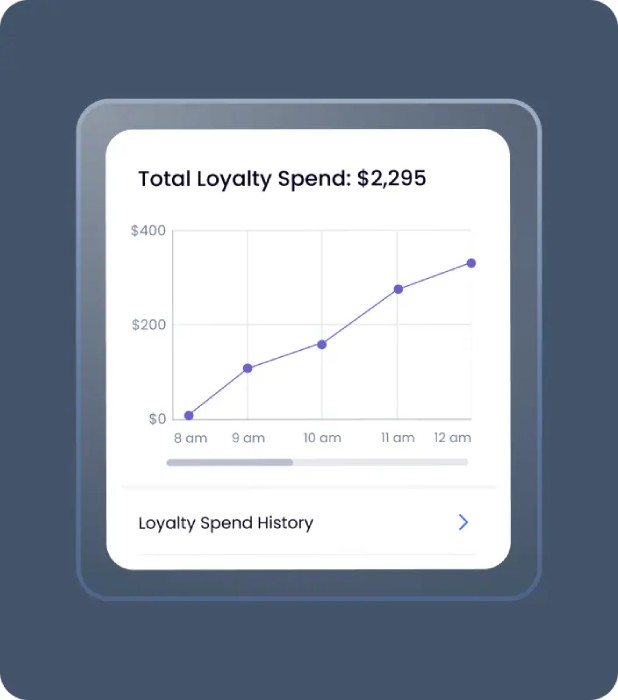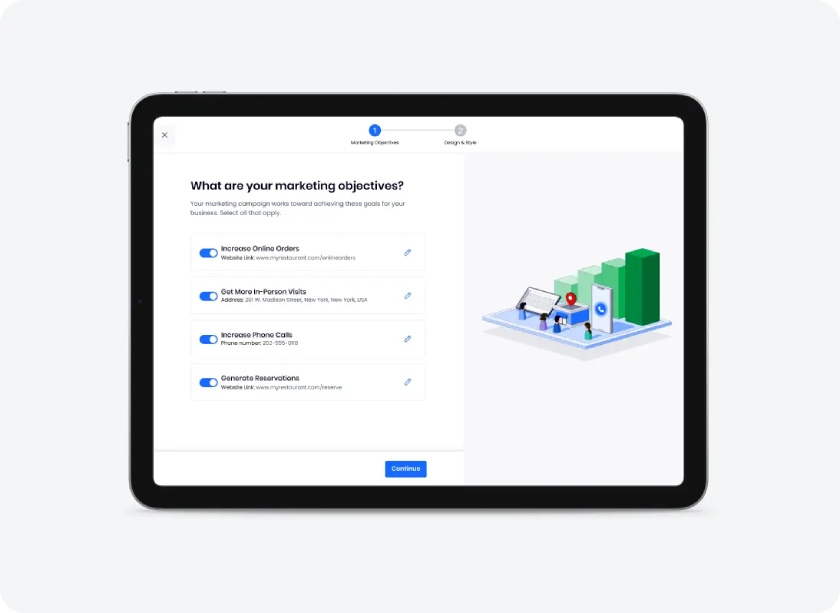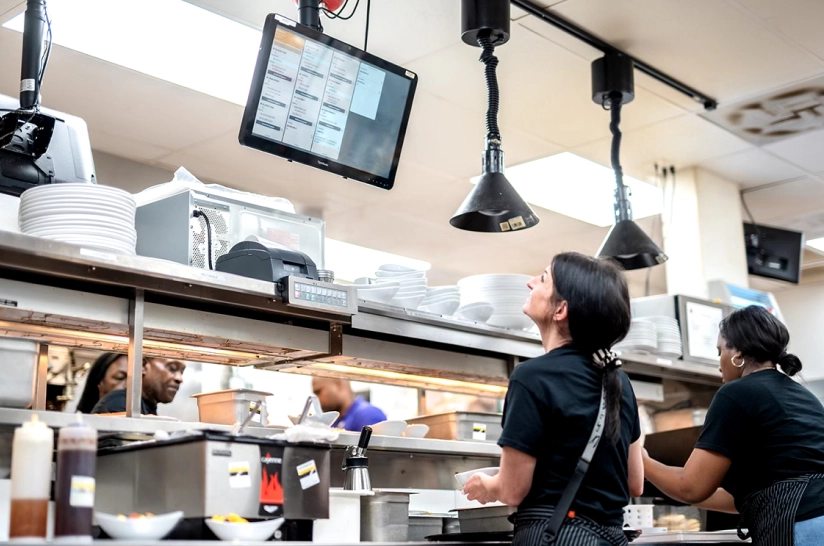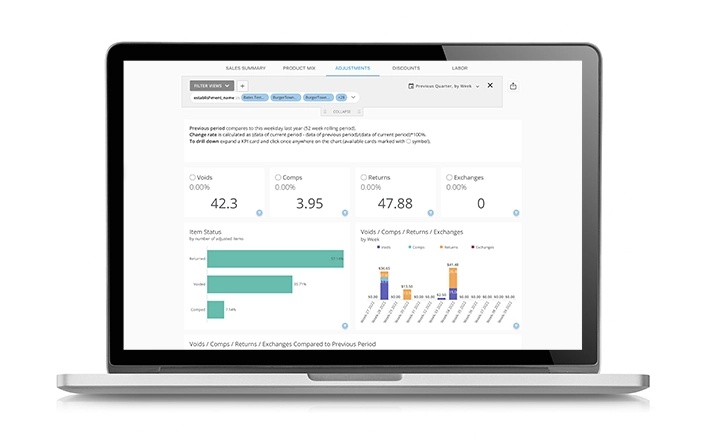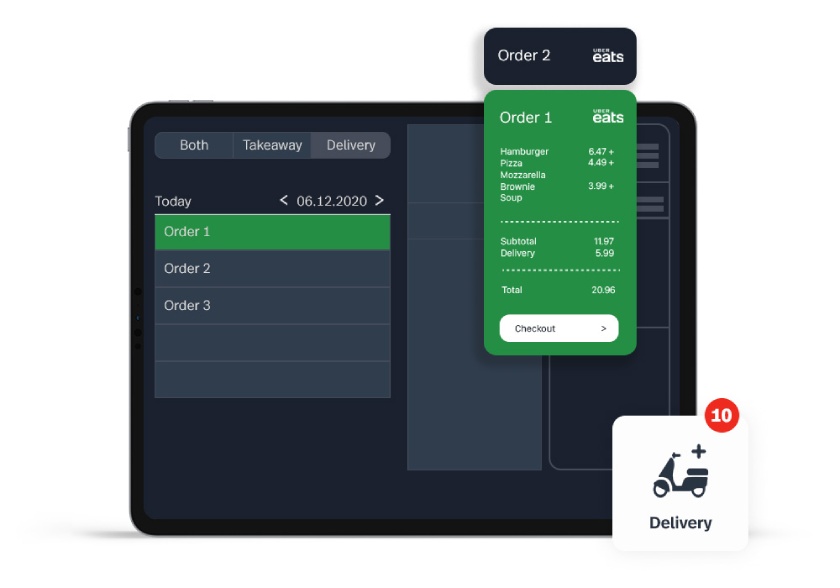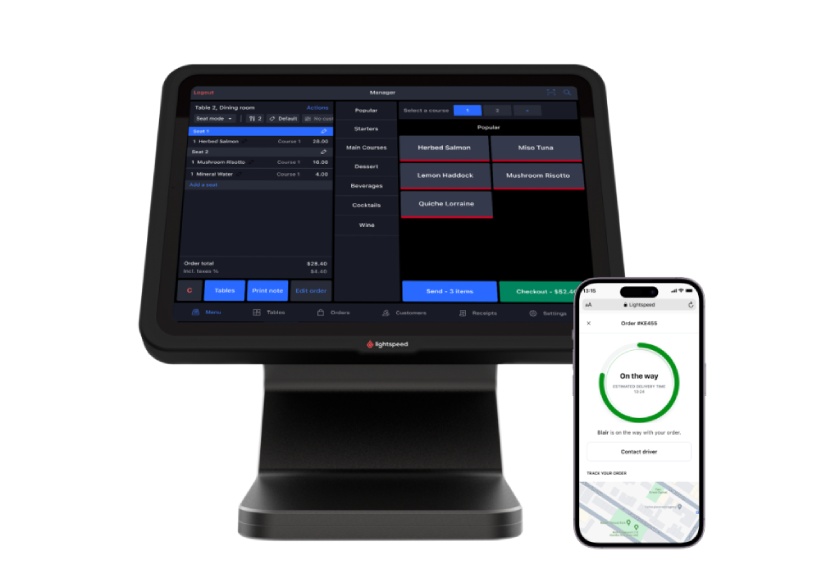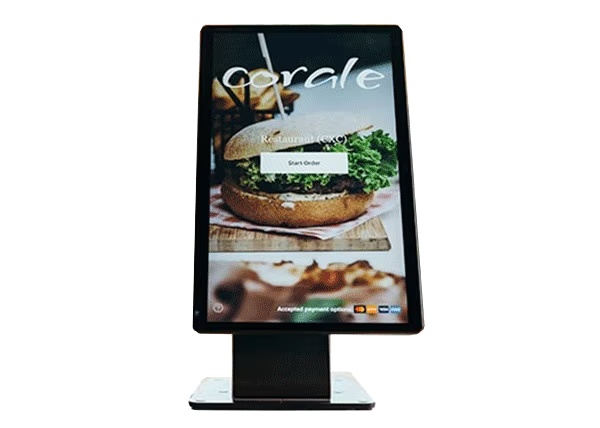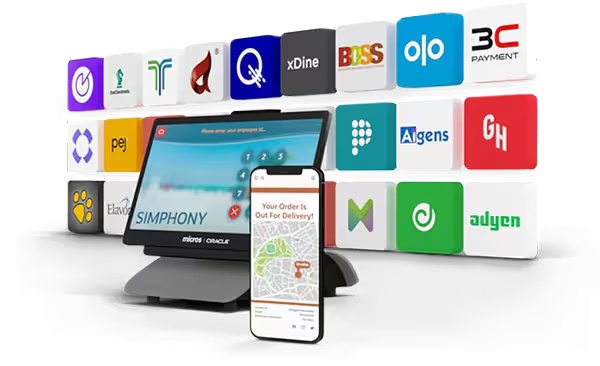Quick-service restaurants (QSRs) need POS systems that allow for fast operations and consistent outcomes across various locations. The best QSR systems combine affordable software with flexible hardware, allowing QSRs to meet customers where they are: in-house, online, curbside, or via drive-thru. POS tools that focus on customer loyalty and an improved customer experience can help restaurants expand and grow sales.
Beyond processing orders and sales, a QSR POS should also offer robust reporting across, inventory management, employee scheduling, and excellent offline functionality. A QSR POS helps you move lines quickly and efficiently. There is a QSR POS available at every price point; I’ve ranked the best for 2024.
The six best POS systems for QSRs in 2024 are:
- Toast: Best overall QSR POS system
- SpotOn: Best for multi-location QSRs
- Square for Restaurants: Best for online ordering & best free QSR POS
- Revel Systems: Best iPad POS for QSRs
- Lightspeed Restaurant: Best for third-party delivery management
- Oracle MICROS Simphony: Best for drive-thru management
Best Quick-service POS Systems Compared
Our Score (out of 5) | Minimum Monthly Software Fees | Contract Length | Payment Processing Fees | |
|---|---|---|---|---|
 | 4.51 | $0 | 2 years | From 2.49% + 15 cents |
4.27 | $0 | Month-to-month | From 1.99% + 25 cents | |
 | 4.08 | $0 | Month-to-month | 2.6% + 10 cents |
 | 4.06 | Custom-quoted | 3 years | Varies by processor |
 | 4.02 | $189 | 1 year | Varies by processor, Lightspeed Payments: 2.6% + 10 cents |
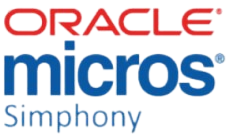 | 3.90 | Custom-quoted | Month-to-month | Varies by procesor |
Toast: Best Overall QSR POS System

Pros
- Rugged, industry-grade hardware withstands high-volume use
- Specialty screened built for quick employee onboarding and efficient order-takin
- Dedicated hub for tracking delivery and takeout orders
- Wealth of integrated hardware peripherals: kitchen display system (KDS), handheld terminals, customer-facing displays, and self-ordering kiosks
Cons
- 2-year contract
- Toast is the only payment processor
- Online ordering and customer loyalty features an extra fee
Overview
Who should use it:
Toast is great for any QSR type but shines specifically for those managing multiple locations or those locations that require diversity in payment/order taking (handhelds, self-serve kiosks, etc.)
Why I picked it:
Toast delivers three key functions that I think make it the best QSR POS software on the market: industry-grade hardware, robust multi-location management, and intuitive modifiers to almost all POS functions. With all of these features in mind, Toast also provides a very affordable base plan, a wealth of support/resources, and an ecosystem that allows for the growth of your QSR business.
This POS offers an overwhelming suite of tools to QSR owners, which can suit a standalone business or a business with 30+ locations across a region. Toast does lack payment processing flexibility and hides some key features behind extra fees, but it delivers the most comprehensive QSR POS offering in 2024.
Monthly software fees:
-
- Starter Kit: $0
- Point of Sale: $69
- Build Your Own: Custom quote
Hardware costs:
-
- Pay-as-You-Go plans include free hardware for up to two terminals (with the Pay-as-You-Go processing rates listed below).
- The standard price for a stationary terminal with a router and card reader is $719.10
- One-time installation fees: $0 for self-installation, $75 – $125/hour for installation, and $400 for a full menu built into the POS
Processing Fees:
- In-person fees for the standard plan: 2.99% + 15 cents
- In-person fees for Starter Kit plan: 2.49% + 15 cents
- Pay-as-you-go hardware: Toast is the only provider on this list that offers its proprietary POS hardware at no upfront cost. This can be a game-changer for small QSRs that need to expand their operations.
- Toast Go 2 handheld terminal: Toast also supports a fully featured handheld terminal, the Toast Go 2, to support line busting and curbside or tableside orders and payments. The Toast Go 2, which fits in an apron pocket and can be operated with one hand, is best-in-class.
- New Benchmarking Tool: Toast has introduced a new Benchmarking Tool a feature no other POS in this guide offers. Toast uses its system-wide metrics to track your sales and operational data to give you a sense of how your business is performing. They allow you to compare the overall progress of your business against similar ones in your region and even break down specific food and drink sales to see how your menu is performing against the market norm.
- Advanced combo building: Toast’s combo builder operates a little differently than the others on this list. Rather than relying on nested modifiers, Toast combos operate as a discount type—discounts are applied automatically on possible combos once added to a check.
- Drive-thru management: Toast offers a detailed, built-in drive-thru order stream. You can find configuration instructions on Toast Central, Toast’s online knowledge database. Once configured, your drive-thru tickets will be color-coded on your KDS screens. You can display order status for customers on an order-ready digital display while alerting customers to their order status via automated text messages.
- Delivery tools: With Toast, you can manage a team of in-house drivers with GPS mapping integrations or opt to send your in-house orders to local third-party drivers for a flat per-delivery fee.
- Handheld and QR code ordering: Toast’s handheld POS devices make it very easy to take orders, especially in busy restaurants. This speed-specific focus allows QSR models to use Toast to expedite lines and get more orders to customers in a timely manner.
Countertop Terminal Kit | Handheld Terminal Kit | Guest Self-service Kit | KDS |
|---|---|---|---|
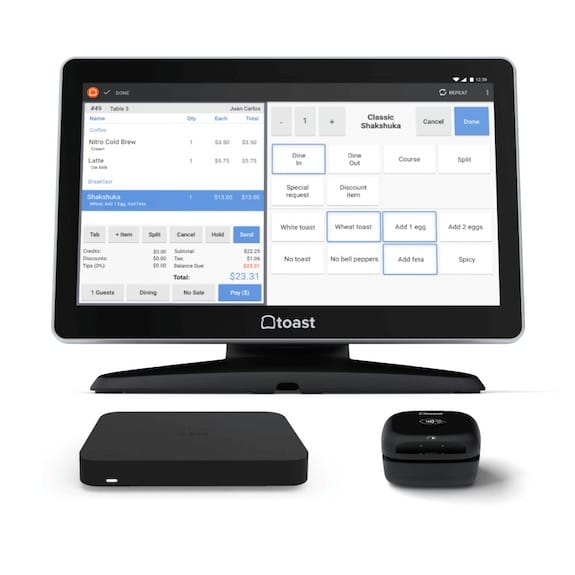 |  |  | 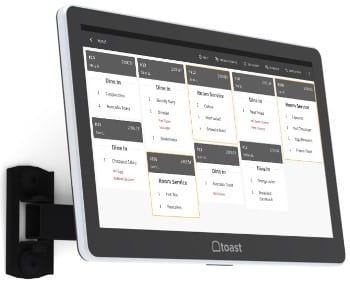 |
Pay-as-you-go: $0 upfront; 3.09% plus 15 cents processing fees Pay upfront: $1,024 plus $69 per month* | Pay-as-you-go: $0 upfront; 3.09% plus 15 cents processing fees Pay upfront: $799.20 plus $69 per month* | Pay-as-you-go: $0 upfront; 3.09% plus 15 cents processing Pay upfront: $1,339.20 plus $99 per month* | Custom quoted; Contact Toast for pricing |
SpotOn: Best for QSRs With Multiple Locations

Pros
- Best-in-class workforce management tools with enforced schedules
- Robust multi-location management features
- Completely customizable order screens and order flows
- Excellent combo-building functions
Cons
- Locked into proprietary terminals
- Locked into SpotOn Payments
- Customizability can lead to longer installation times
Overview
Who should use it:
Growing QSRs, those needing an industry-leading but easy-to-use POS system, and those with multiple locations are suited to the robust suite of features SpotOn offers.
Why I picked it:
SpotOn’s tools are seamlessly fine-tuned for QSRs with many locations: marketing AI tools, a robust mobile reporting app, and the ability to grow customer loyalty across multiple sites. It also offers in-depth employee management features, making it easy to schedule staff, execute payroll, and view hours worked across all of your locations. The entirety of SpotOn’s software is customizable, which allows your SpotOn experience to be unique to your business. The most successful QSRs are able to build out their own personalized POS systems, and SpotOn gives you this opportunity.
This system’s robust QSR features and comprehensive support make it especially ideal when it needs to be set up multiple times in new locations.
- Monthly Subscription Plans:
- Quick Start: $0; both software and hardware fees are covered by payment processing fees
- Counter-service: $99, +$3 per employee
- Full-service: $135, +$3 per employee
- Customize Your Own: Custom-quoted
- Hardware:
- Station POS: $750
- Counter POS: $850
- Kitchen Display System: $600
- Processing Fees:
- Quick Start: 2.89% + $0.25
- Counter-service, Full-service, Customize Your Own: 1.99% + $0.25
- Robust workforce management: SpotOn Teamwork is SpotOn’s built-in employee management tool. Teamwork includes a scheduling app that can track employee availability, organize time-off requests, and handle shift swaps. The tool is so popular that it also integrates with the Toast, Square, Clover, Lightspeed, and Revel POS systems. Users claim the Teamwork system saves them up to 20 hours per week on labor management tasks.
- Customizable workflows: The SpotOn team custom-builds the POS for every new customer. So, if you want your order screens to appear in a specific layout, want to offer dynamic pricing that supports cash discounting, or need multiple revenue categories to support granular reporting, you can typically get any customization you need. This level of customization can mean that onboarding with SpotOn will take longer than with a self-installable system like Square. But if you have complex needs, the lead time likely won’t bother you.
- Online ordering and delivery management: SpotOn’s built-in online ordering tools start with an eye-catching online ordering website. Orders are sent directly to your POS order stream. You can manage self-delivery or takeout orders in-house with built-in two-way SMS text messaging (most other POS systems on our list only support one-way text messaging).
- Dynamic hardware: Like Toast, SpotOn operates on industry-grade hardware. However, SpotOn’s hardware is slightly sleeker and more flexible than Toast’s. You can choose standard or low-profile countertop terminals that can be set up in multiple configurations with built-in card readers and customer-facing displays. SpotOn’s kitchen display system (KDS) screens are dynamic and user-friendly, and the handheld POS devices include a QR code reader so your team can quickly scan promotional coupons tableside.
- QSR time-efficient tools: SpotOn’s many different POS tools deliver speed and efficiency in many different aspects of the restaurant. Instant digital receipts, one-tap tipping, and an all-day view all help keep the product moving. Prep timers communicated through the KDS ensure food gets out on time and will even change colors depending on the urgency of the situation.
- CRM and loyalty tools: SpotOn delivers great loyalty rewards and keeps you connected to your guests with automated marketing features and website tools. The focus on loyalty and rewards tracking keeps customers wanting to come back, which is key for QSR growth.
Stationary Terminal | Handheld Terminal | Self-service Kiosk | KDS |
|---|---|---|---|
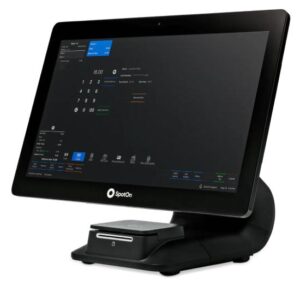 | 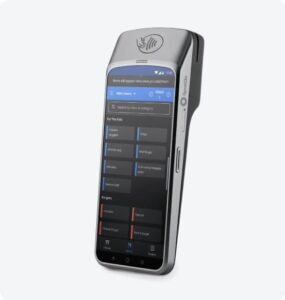 | 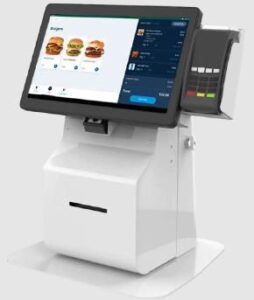 | 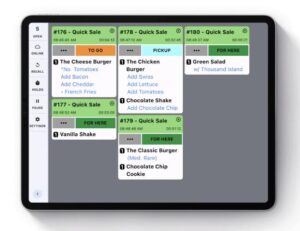 |
Countertop touch-screen terminal with built-in card reader | Handheld order and payment device | Countertop mounted self-service kiosk | Touch-screen kitchen display system screen |
Square for Restaurants: Best for Online Ordering & Best Free QSR POS

Pros
- Baseline POS subscription is free
- Free online ordering site
- User-friendly KDS, handheld terminal, and multiple options for self-service kiosks
- Real-time menu updates
Cons
- No drive-thru management tools
- Square is the only available payment processor
- Very limited mobile reporting data
Overview
Who should use it:
Square for Restaurants is great for QSR businesses that offer online ordering, want a cost-effective POS, and do not have to manage a drive-thru.
Why I picked it:
Square for Restaurants continues to be a great, low-cost option for QSR business owners. It offers an excellent online ordering platform and encourages customer growth through an online ordering app tailored to your business. Square’s online ordering app also features conversational modifiers and repeat order buttons. The system is so efficient that customers can re-order online with just three taps.
Square’s ability to sync menus and inventory in real time helps ensure all of your stations are ready to go during a busy service. It is also very user-friendly, claiming that staff can be trained on the system in less than 15 minutes. While it lacks drive-thru management tools and locks some features behind fees, Square is a great economical option for QSR businesses.
- Monthly software costs:
- Free: $0
- Plus: $69
- Premium: $165
- Hardware Costs:
- From $59 for a card reader (though Square will send your first card reader for free) to $1,389for a complete Square POS kit with a stand, cash drawer, card reader, Square Terminal, receipt printer, and kitchen printer (iPad not included)
- $0 installation; Square is self-installed, but you can request on-site installation assistance for $600
- Processing fees:
- 2.6% + 10 cents for in-person transactions
- 2.9% + 30 cents for online or invoice transactions
- 3.5% + 15 cents per transaction for manually keying in a customer’s credit card
- Pocket-sized Square Terminal: Square’s Terminal is a handheld order and payment device that fits in a pocket. Unlike other handheld devices on this list, Square Terminal also includes a built-in receipt printer. It is excellent for line-busting in busy QSRs.
- Free basic POS: Square for Restaurants’ entry-level POS subscription is available for no monthly fees. If you have a compatible iPad, you can get started with Square for Restaurants at no upfront cost. Most QSRs will only need this level, making it an affordable yet functional option.
- Free online ordering site: Via the integrated Square Online Store, Square for Restaurants users can add an online ordering site for free. If your restaurant does not have a website, you can host your online ordering page on a Square web address for no additional cost. Square’s free POS operates on the equipment you already have, which gives it the edge in free online ordering.
- No long-term contracts: Square for Restaurants does not require a long-term service contract. You can use the POS for a month or a year and leave at any time. You can also shift to a different subscription tier easily as your business grows or your needs change.
- Integrated KDS: Square for Restaurants recently added an integrated KDS (it formerly relied on FreshKDS). This new function is a great option for QSRs that need a cost-effective solution. Like the rest of the Square for Restaurants system, the Square KDS operates on iPads. You can download the software for the KDS from the Apple App Store.
- Great user reviews: While not a feature, Square enjoys great user reviews across many reputable sites, including Trustpilot and Capterra. Square has definitely grown into one of the most popular POS systems in the industry, and reviews by users showcase why it has been widely adopted.

Square for Restaurants offers great KDS capabilities across your kitchen stations. (Source: Square)
Stand | Terminal | Stand Restaurant Station | Stand Mount |
|---|---|---|---|
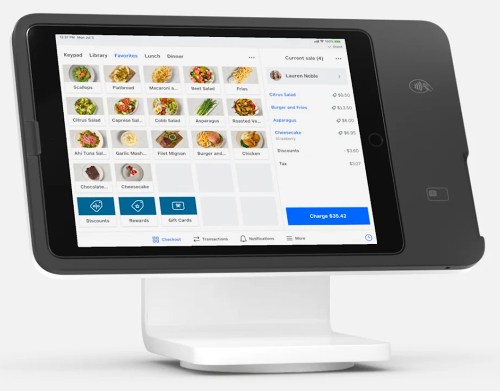 | 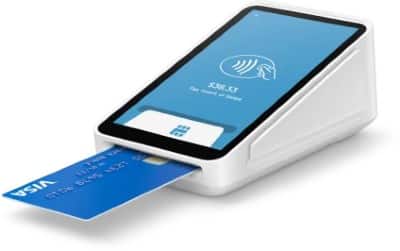 | 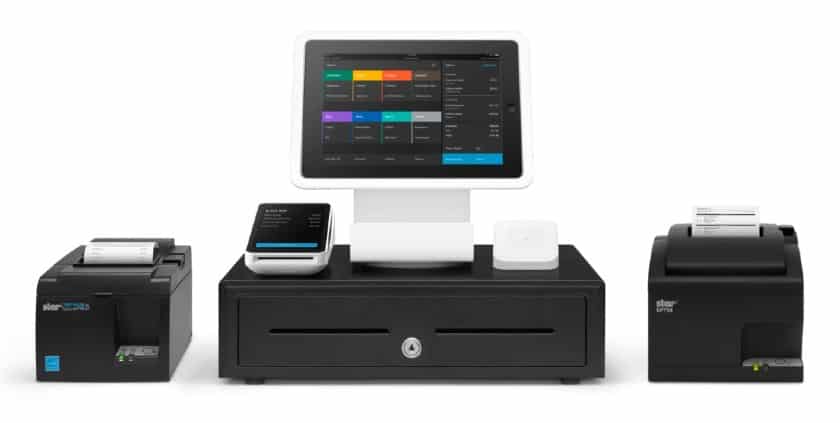 | 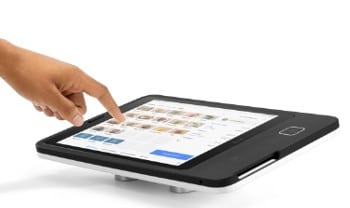 |
$149 ($14 per month for 12 months)* | $299 ($27 per month for 12 months) | $1,019* | $149 ($14 per month for 12 months)* |
Payment-enabled iPad stand | Handheld order and payment terminal with integrated receipt printer | Complete POS including Square stand, cash drawer, and receipt printer | Counter or wall mount for POS or self-service kiosks |
*Price without an iPad; with an iPad, add $349.
Revel Systems: Best iPad POS for QSRs

Pros
- Intuitive iPad design can be great for training staff across QSR businesses
- Dynamic menu modifiers can streamline complex orders for quicker customer experiences
- Multiple payment processing options
Cons
- 3-year contract
- Best pricing requires enrollment in Revel Payments
- Pricey for smaller QSR concepts
Overview
Who should use it:
Revel Systems is great for QSR concepts that want iPad-based POS software for their multiple locations. Additionally, users who want flexibility in payment processing will find value in Revel.
Why I picked it:
Revel Systems is native to iPads and is designed to run on these devices. This makes the system very easy to learn, with many being used to the Apple ecosystem. What helps Revel in the QSR space is the fact that it delivers a lot of great QSR options in a package that makes it easy to implement into your business. With features such as drive-thru management and complex order modifiers, it is a robust offering on one of the most popular devices in which a POS system can exist.
The system’s biggest drawback is its historically expensive POS subscription. All tiers are now custom-quoted, and this lack of pricing transparency holds Revel back on our list. If pricing is not a major concern and you want POS software that is intuitive for new staff members to use, then Revel Systems is a great option for your QSR concept. While Square is also iPad-intuitive, Revel delivers drive-thru management, which makes it quintessential for this technology type.
- Monthly software costs: Custom-quoted
- Hardware Costs: Custom-quoted
- Processing fees: Custom-quoted; choose from Revel Advantage, First Data, Heartland, TSYS, Worldpay, Chase Paymentech, Elavon
- Digital order flow: Revel systems emphasize a streamlined digital experience, capturing customer orders and routing them to their KDS screens in your kitchen. You can customize how your kitchen display appears, and you can even set up digital notification boards for order status at your expo station.
- Delivery XT: Revel offers its own in-house delivery system, helping you avoid third-party fees and consolidating this aspect of your business into your existing software. This software is great for concepts with a lot of delivery orders or those looking to introduce delivery into their repertoire.
- Customer engagement: Revel offers great customer loyalty and engagement opportunities for QSRs. Growing a customer base is vital for QSRs, and Revel has dedicated programs to help grow your base and deliver vital reward programs for QSRs to leverage.
- Driver management: Revel includes live, maps-based driver management: the Delivery XT Dispatch app. If you manage a team of in-house delivery drivers, Revel shows you their live locations on a dispatch map. You can assign orders based on proximity directly from the map and manage driver reimbursements based on mileage.
- Driver smartphone app: Revel includes a free driver app, Revel Delivery XT Agent, that syncs with your dispatch system. Drivers are notified in their app about new delivery assignments, updated delivery information, and real-time turn-by-turn directions. This driver app gives you Uber-like control over your delivery fleet. It is an excellent fit for restaurants like pizzerias that do a high volume of deliveries.
Apple iPad | Revel C-stand | Revel L-stand |
|---|---|---|
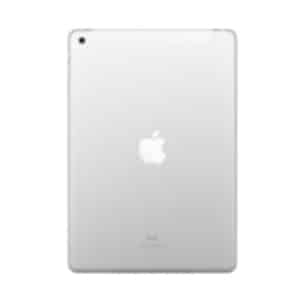 | 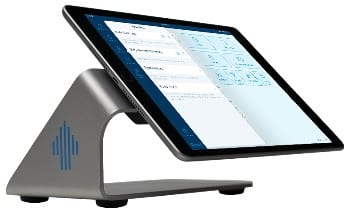 | 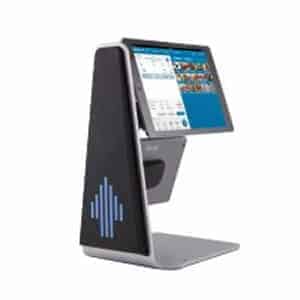 |
10.2-inch to 12.9-inch display for POS, KDS, and self-service kiosk screens | Low-profile iPad stand for POS terminals or self-service kiosks | iPad terminal stand with customer-facing display |
Lightspeed Restaurant: Best for Third-party Delivery Management

Pros
- Intuitive online order screen for multiple delivery apps
- Self-installable
- Excellent customer data tracking
Cons
- Limited drive-thru management
- A higher price baseline tier may be too much for some
- Limited mobile reporting
Overview
Who should use it:
QSR concepts that rely on a lot of different third-party delivery orders will find massive success with Lightspeed Restaurant. Additionally, it is suitable for concepts that want complete control of editing online ordering menus.
Why I picked it:
Lightspeed Restaurant is a great option for QSRs due to its intensive and intuitive third-party delivery management. Lightspeed consolidates all orders from different sites into your KDS screens, giving your kitchen a broad view of all of the orders it needs to manage and maintain. On top of this, you can edit and sync your delivery menus from one app, allowing changes to be easily reflected in all of your connected platforms.
Lightspeed scored well due to its great third-party order management and efficient POS design. However, I docked points for its higher pricing and consolidation of pricing tiers—an increase from $69/month to $189/month, making the baseline POS more expensive. That being said, some key features, such as inventory management, are now included in the base POS offering and do not require an extra fee.
- Monthly subscription plans*:
- Essentials: $189
- Premium: $399
- Enterprise: Custom quote
* Prices are lower for users who pay fees annually and enroll in Lightspeed Payments.
- One-time Installation fee: None
- Payment processing: Lightspeed Payments starts at 2.6% + 10 cents for in-person payments.
- Quick service mode: Lightspeed Restaurant includes a quick service setting that reduces the number of button presses required to ring up a new order and process payment. Unfortunately, this mode does not support barcode scanning to add ready-to-eat (RTE) and ready-to-drink (RDT) items to orders.
- Consolidated third-party delivery: Via integration with Deliverect, Lightspeed Restaurant consolidates all of your third-party delivery platforms into a single dashboard. You can configure online-only menus and manage each of your third-party platform subscriptions from a single place. Orders print to your kitchen or KDS screen seamlessly. This is helpful for any restaurant size as it streamlines orders, especially during a busy dinner rush.
- Flexible hardware: In addition to iPad-based terminals, Lightspeed Restaurant uses iPads for KDS, customer-facing displays, and self-service kiosks, so you can customize your POS by pressing a few buttons in the manager dashboard. These screens all feature Lightspeed’s intuitive interface.
- Popular integrations: In addition to Lightspeed’s extensive add-on functions, this restaurant POS integrates with 80-plus third-party software tools. You can find popular options for employee scheduling, inventory, website management, reservations, accounting, payroll, and third-party delivery platforms.
- Delivery menu customizations: Lightspeed Restaurant allows you to update your online delivery menus in real-time across all platforms at once. You can also create delivery-only menus online, locking out takeout and dine-in options and only providing delivery-based menu options to online platforms. This level of customization and management makes managing delivery a breeze for QSR concepts.
Terminal Kit | Verifone P400 | Mobile Case |
|---|---|---|
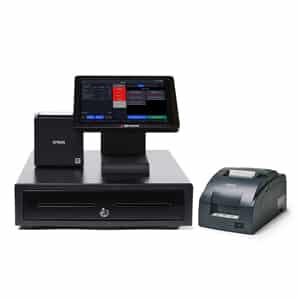 | 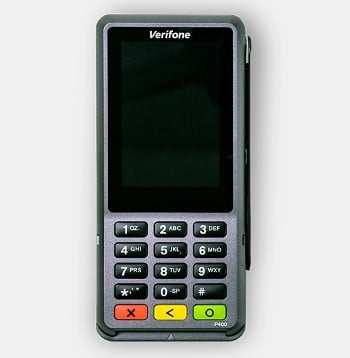 | 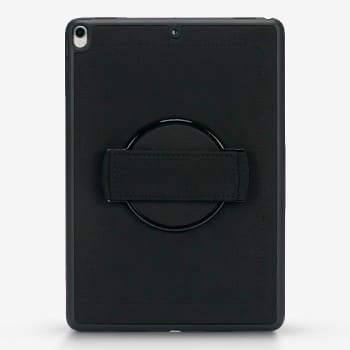 |
iPad stand, cash drawer, receipt printer, and kitchen printer | Mobile, PIN-enabled tap, swipe, and dip card reader | Rugged handheld case for iPad |
Oracle MICROS Simphony: Best for Drive-thru Management

Pros
- Robust drive-thru management tools
- Payment processing flexibility
- Option for an on-site server
Cons
- Hardware is custom-quoted
- No free trial or free baseline subscription
- Many general POS features require and additional fee
Overview
Who should use it:
QSR concepts that need drive-thru management or want to expand their drive-thru capabilities should consider using the Oracle MICROS Simphony system.
Why I picked it:
Oracle MICROS Simphony is a POS system I have extensive experience with, using the software in a restaurant I helped manage. The cloud-based offering from Oracle combines industry-grade, rugged hardware with intuitive software design, making it an ideal choice for QSR concepts. Oracle’s drive-thru management tools are the most comprehensive in this guide, allowing support for multi-lane and designated pickup options, as well as the ability to take orders curbside, similar to concepts like Culver’s or Chick-fil-A.
The system lost a few points due to some extra fees for some baseline POS features and mixed user reviews. Additionally, its hardware is custom-quoted, making it hard to compare to other systems without doing a deep dive with an Oracle representative.
- Monthly Software Fees: Oracle’s subscription fees are now all custom-quoted.
- One-Time Installation Fees: Custom-quoted
- Processing Fees: Varies by processor
- Centralized multilocation dashboard: Adding new locations to your Simphony dashboard only takes a few minutes. You can easily run reports for single locations or compare multiple locations in a single report. All information is accessible via a central dashboard, so you don’t need to log into various back-office dashboards and run multiple reports.
- Drive-thru management: Simphony’s drive-thru management includes tools for managing a traditional drive-thru alongside curbside pickup monitoring. You can keep track of which numbered parking spaces customers arrive in, note vehicle type, and close out orders at the drive-thru window or via a handheld terminal in the parking lot. Additionally, Oracle offers the ability to manage multi-lane drive-thrus, a perfect tool for those looking to expand their drive-thru capabilities.
- Rugged, customizable hardware: Like top-ranked Toast, Simphony operates on hardware that has been designed to withstand a demanding restaurant environment. Terminals are sealed to prevent the intrusion of steam, water, and dust. They can also operate at higher and lower temperatures than an iPad.
- Multilanguage support: Your Simphony POS can operate in more than 20 languages. So, if your restaurant operates in multiple countries, you can use the same system in the local language. This supports QSRs that want to expand on a grand scale. Simphony is the only option on this list that has this language option.
Workstation 6 Series | Tablet 700 Series | Self-Service Kiosk | KDS |
|---|---|---|---|
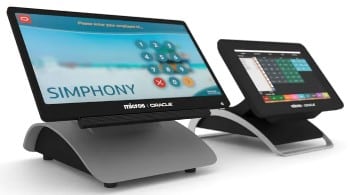 | 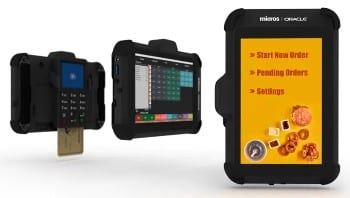 | 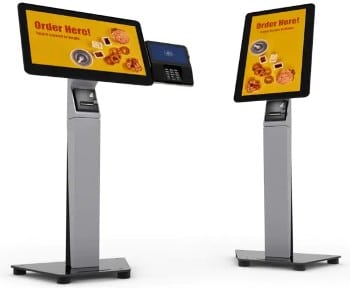 | 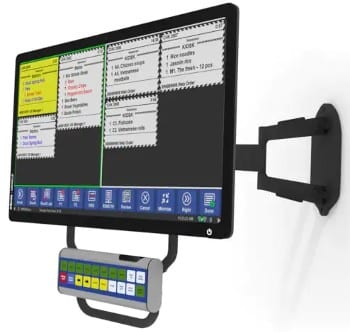 |
Countertop, touch-screen POS terminal | Touch-screen handheld order and payment device | Touch-screen kiosk | Bump-bar enabled KDS screen |
How to Choose a QSR POS in 5 Steps
Choosing the best QSR POS for your restaurant is a straightforward process. You’ll need to take a bit of time to ensure you find the best fit. Follow these steps to find the best QSR POS:
Step 1: Assess Your Needs
First—and most importantly—you need to understand the business you have and the functions you require for your QSR POS. Are you a one-unit small business with limited capital to deploy? Or are you a 20-unit QSR group with the necessary cash flow to invest in a POS with centralized multilocation management? Understanding not only what you can afford but also the basic needs you require of POS software is integral to your choice.
Step 2: Consider Your Staff’s Needs
Before committing to POS software, understand if it makes sense for the people you employ. Does it need to be multilingual? Is there a lot of training and time needed to understand the system on a functional level? Understanding not only the POS capabilities but also how your staff will work with it is crucial before investing the money and time you will dedicate when purchasing this software.
Step 3: List Your Must-haves
Having a list of must-have features is very important during this process. You should not commit to software that will not fulfill your needs, which will then negatively impact your customers. Understanding what is absolutely crucial to you as an operator is vital in the selection process. This also goes for the contract you will sign. Are you willing to sign up for more than one year? Do you need your software to be month-to-month billing? Know this before making a final decision.
Step 4: Shop Around & Accept Demos
Let QSR POS providers sell to you! Accept free demos, take calls with sales teams, and do not settle on just one provider. Make it clear you are looking to invest in a POS system for your business and do not be afraid to share that you are shopping around. Letting POS providers share the system’s unique features and comparing with other providers will allow you to see which system suits your needs and also reveals any gaps in service.
Step 5: Choose Your QSR POS Software & Sign Up
The last part is committing and signing up for the software. This also means doing the work on your end as an operator to ensure you know the system better than anyone else. Take time to learn all of the functionalities of the POS in your unique setting. Being able to train your staff and get the most out of the service you are paying for should be your end goal.
How We Evaluated QSR POS Systems
Evaluating the QSR POS systems in this guide was a robust process, as you will see in our scoring criteria below. Looking at a range of factors, from affordability to multi-location management, led to some in-depth analysis of every system’s current offering in 2024. Below are the five different categories we used to determine the best POS systems for quick-service restaurants.
15% of Overall Score
What was key for our pricing score was the affordability of the base plan, if free trials were offered, and what kind of payment processing was offered. Furthermore, we took into account the maximum number of users allowed per system, the hardware options offered, and if order volume discounts were offered.
20% of Overall Score
Some general POS features we believed each system should have included inventory management, workforce management tools, and online ordering. Beyond this, CRM/loyalty, gift cards, and reporting capabilities were also considered.
25% of Overall Score
20% of Overall Score
20% of Overall Score
Lastly, our expert score took into account the overall package each quick-service POS software provided. General features, value for the base subscription being paid, and industry popularity were all weighed here. Customer reviews off of Capterra and real-world sentiment on how easy each system was to operate in these reviews were also considered.
Meet the Experts
 | Ray Delucci has 10 years of food industry experience and has managed full-service restaurants and large events and has worked in food development as well. His experience in different restaurant industry sectors gives him insight into what a quality POS needs. |
 | Mary King has worked in every food service business from coffee shops and pizzerias to full-service fine dining restaurants. With over 14 years of industry experience, she has used many POS systems in real-world food service businesses. |
 | Meaghan Brophy has 10-plus years of retail experience, during which she has operated a variety of cash registers and POS systems in different settings and applications. Since working in retail, Meaghan has 7-plus years of experience writing for retailers and 4-plus years of experience evaluating POS systems. |
Frequently Asked Questions (FAQs)
Below are the most frequently asked questions when it comes to quick-service restaurant POS systems.
The best POS for a quick-service restaurant is one that can handle your sales volume at a price you can afford. The best POS for your QSR will vary based on whether you need to track inventory, manage a drive-thru, or other functions. In our most recent QSR POS ranking, we found that Toast is the best POS for independent quick-service restaurants.
Fine dining restaurants utilize POS systems that can manage dining rooms efficiently, track staff performance accurately, and take account of each customer that dines at their restaurant. Fine dining systems rely on the ability to make each experience unique and special, so having customer profiles that are detailed and robust is key for most fine dining POS systems. Beyond this, having the ability to modify orders and accurately relay information through KDS screens in the kitchen is key for this restaurant type.
There is no one-size-fits-all POS system for restaurants. However, some of the top systems in the country utilize Toast, Square for Restaurants, Oracle MICROS Symphony, and others in this guide. Every POS system offered has a unique restaurant setting in which its features are best utilized. This is the reason why a diverse range of POS systems is used throughout the food industry.
The profit margin for a quick-service restaurant lies anywhere between 5% to 9%, depending on the business and its unique financial impact factors. This rate is significantly higher than a full-service restaurant, which sits between 3% to 5%. The reason a QSR has a higher profit margin is due to lower labor costs, quicker table turnover, and a higher variety of channels in which business is received (takeout, drive-thru, online ordering).
It is hard to say what type of restaurant will consistently make the most money, but concepts such as ghost kitchens and fast food restaurants often have higher profit margins. In some cases, bars or wine bars can have high profit margins if managed right. Finally, fine dining restaurants can be very profitable if the demand for their product can help inflate the price to a high profitability level.
Bottom Line
Toast leads our guide with a resounding 4.51 out of 5 due to its cost-effective plans, robust hardware, and key QSR features. Some of these features include drive-thru management, combo building, and the ability to support QSRs of any size. Self-ordering kiosks, handheld terminals, customer-facing displays, and intuitive KDS screens ensure you can produce consistent, quality food throughout one or many QSR locations. To see if Toast is the best fit for your QSR, contact Toast for a full demo.
